Co-Combustion of Coal and Biomass: Heating Surface Slagging and Flue Gases
Abstract
1. Introduction
2. Materials and Methods
2.1. Materials
2.2. Experimental Setup for Conductive Heating
2.3. Experimental Setup for Convective Heating
2.4. Experimental Setup for Analyzing Flue Gas Composition
3. Results and Discussion
3.1. SEM of Fuel Particles
3.2. Combustion Process of Individual Fuels and Mixtures in Conductive Heating
3.3. Combustion Process of Fuels and Fuel Mixtures Under Convective Heating
3.4. Analysis of Gaseous Emissions During Combustion of Fuels and Fuel Mixtures
3.5. Tendency of Fuels to Undergo Slagging
4. Practical Application
5. Conclusions
Supplementary Materials
Author Contributions
Funding
Institutional Review Board Statement
Informed Consent Statement
Data Availability Statement
Conflicts of Interest
References
- Filonchyk, M.; Peterson, M.P.; Zhang, L.; Hurynovich, V.; He, Y. Greenhouse gases emissions and global climate change: Examining the influence of CO2, CH4, and N2O. Sci. Total Environ. 2024, 935, 173359. [Google Scholar] [CrossRef] [PubMed]
- Hou, H.; Lu, W.; Liu, B.; Hassanein, Z.; Mahmood, H.; Khalid, S. Exploring the Role of Fossil Fuels and Renewable Energy in Determining Environmental Sustainability: Evidence from OECD Countries. Sustainability 2023, 15, 2048. [Google Scholar] [CrossRef]
- Paramati, S.R.; Shahzad, U.; Doğan, B. The role of environmental technology for energy demand and energy efficiency: Evidence from OECD countries. Renew. Sustain. Energy Rev. 2022, 153, 111735. [Google Scholar] [CrossRef]
- Autelitano, K.; Famiglietti, J.; Aprile, M.; Motta, M. Towards Life Cycle Assessment for the Environmental Evaluation of District Heating and Cooling: A Critical Review. Standards 2024, 4, 102–132. [Google Scholar] [CrossRef]
- Chu, W.; Vicidomini, M.; Calise, F.; Duić, N.; Østergaard, P.A.; Wang, Q.; da Graça Carvalho, M. Recent Advances in Low-Carbon and Sustainable, Efficient Technology: Strategies and Applications. Energies 2022, 15, 2954. [Google Scholar] [CrossRef]
- Si, M.; Liu, J.; Zhang, Y.; Liu, B.; Luo, Z.; Cheng, Q. Effect of co-combustion of coal with biomass on the morphology of soot. Renew. Energy 2024, 226, 120374. [Google Scholar] [CrossRef]
- Yuan, Y.; Zuo, H.; Wang, J.J.; Gao, Y.; Xue, Q.; Wang, J.J. Co-combustion behavior, kinetic and ash melting characteristics analysis of clean coal and biomass pellet. Fuel 2022, 324, 124727. [Google Scholar] [CrossRef]
- Adeleke, A.A.; Ikubanni, P.P.; Emmanuel, S.S.; Fajobi, M.O.; Nwachukwu, P.; Adesibikan, A.A.; Odusote, J.K.; Adeyemi, E.O.; Abioye, O.M.; Okolie, J.A. A comprehensive review on the similarity and disparity of torrefied biomass and coal properties. Renew. Sustain. Energy Rev. 2024, 199, 114502. [Google Scholar] [CrossRef]
- Liu, L.; Memon, M.Z.; Xie, Y.; Gao, S.; Guo, Y.; Dong, J.; Gao, Y.; Li, A.; Ji, G. Recent advances of research in coal and biomass co-firing for electricity and heat generation. Circ. Econ. 2023, 2, 100063. [Google Scholar] [CrossRef]
- Sahu, S.G.; Chakraborty, N.; Sarkar, P. Coal–biomass co-combustion: An overview. Renew. Sustain. Energy Rev. 2014, 39, 575–586. [Google Scholar] [CrossRef]
- Baxter, L. Biomass-Coal Cofiring: An Overview of Technical Issues. In Solid Biofuels for Energy: A Lower Greenhouse Gas Alternative; Springer: Berlin/Heidelberg, Germany, 2011; pp. 43–73. [Google Scholar] [CrossRef]
- Yi, B.; Chen, M.; Gao, Y.; Cao, C.; Wei, Q.; Zhang, Z.; Li, L. Investigation on the co-combustion characteristics of multiple biomass and coal under O2/CO2 condition and the interaction between different biomass. J. Environ. Manag. 2023, 325, 116498. [Google Scholar] [CrossRef] [PubMed]
- Xu, L.; Zhu, G.; Niu, Y. Effect of preheating Co-firing of biomass and coal on the synergistic reduction of PM and NO source emissions. J. Clean. Prod. 2023, 414, 137562. [Google Scholar] [CrossRef]
- Yang, X.; Song, G.; Li, Z.; Song, Q. Effect of biomass-coal blending combustion on Pb transformation. J. Hazard. Mater. 2024, 461, 132697. [Google Scholar] [CrossRef]
- Du, S.; Wang, J.; Yu, Y.; Zhou, Q. Coarse-grained CFD-DEM simulation of coal and biomass co-gasification process in a fluidized bed reactor: Effects of particle size distribution and operating pressure. Renew. Energy 2023, 202, 483–498. [Google Scholar] [CrossRef]
- Chaiyo, R.; Wongwiwat, J.; Sukjai, Y. Numerical and Experimental Investigation on Combustion Characteristics and Pollutant Emissions of Pulverized Coal and Biomass Co-Firing in a 500 kW Burner. Fuels 2025, 6, 9. [Google Scholar] [CrossRef]
- Yang, X.; Zhao, Z.; Zhao, Y.; Xu, L.; Feng, S.; Wang, Z.; Zhang, L.; Shen, B. Effects of torrefaction pretreatment on fuel quality and combustion characteristics of biomass: A review. Fuel 2024, 358, 130314. [Google Scholar] [CrossRef]
- Dula, M.; Kraszkiewicz, A. Theory and Practice of Burning Solid Biofuels in Low-Power Heating Devices. Energies 2025, 18, 182. [Google Scholar] [CrossRef]
- Wang, X.; Xu, J.; Ling, P.; An, X.; Han, H.; Chen, Y.; Jiang, L.; Wang, Y.; Su, S.; Hu, S.; et al. A study on the release characteristics and formation mechanism of SO2 during co-combustion of sewage sludge and coal slime. Fuel 2023, 333, 126511. [Google Scholar] [CrossRef]
- Wang, X.; Luo, Z.; Wang, Y.; Zhu, P.; Wang, S.; Wang, K.; Yu, C. NO emission during the co-combustion of biomass and coal at high temperature: An experimental and numerical study. J. Energy Inst. 2024, 115, 101707. [Google Scholar] [CrossRef]
- Hariana; Putra, H.P.; Prabowo; Hilmawan, E.; Darmawan, A.; Mochida, K.; Aziz, M. Theoretical and experimental investigation of ash-related problems during coal co-firing with different types of biomass in a pulverized coal-fired boiler. Energy 2023, 269, 126784. [Google Scholar] [CrossRef]
- Roy, R.; Schooff, B.; Li, X.; Montgomery, S.; Tuttle, J.; Wendt, J.O.L.; Dickson, K.; Iverson, B.; Fry, A. Ash aerosol particle size distribution, composition, and deposition behavior while co-firing coal and steam-exploded biomass in a 1.5 MWth combustor. Fuel Process. Technol. 2023, 243, 107674. [Google Scholar] [CrossRef]
- Karuana, F.; Prismantoko, A.; Suhendra, N.; Darmawan, A.; Hariana, H.; Darmadi, D.B.; Akhsin Muflikhun, M. Investigation of austenitic stainless steel corrosion resistance against ash deposits from co-combustion coal and biomass waste. Eng. Fail. Anal. 2023, 150, 107368. [Google Scholar] [CrossRef]
- Mo, W.; Du, K.; Sun, Y.; Guo, M.; Zhou, C.; You, M.; Xu, J.; Jiang, L.; Wang, Y.; Su, S.; et al. Technical-economic-environmental analysis of biomass direct and indirect co-firing in pulverized coal boiler in China. J. Clean. Prod. 2023, 426, 139119. [Google Scholar] [CrossRef]
- Fakourian, S.; Roberts, M.; Dai, J. Numerical prediction of ash deposit growth burning pure coal and its blends with woody biomass in a 1.5 MWTH combustor. Appl. Therm. Eng. 2023, 224, 120110. [Google Scholar] [CrossRef]
- Lee, D.-G.; Lee, J.-H.; Kim, G.-M.; Jeong, J.-S.; Kim, S.-M.; Jeon, C.-H. The Initial ash deposition formation in horizontal combustion reactor for blending torrefied biomass wood pellets and coals. Renew. Energy 2024, 226, 120198. [Google Scholar] [CrossRef]
- Díez, L.I.; García-Mariaca, A.; Llera-Sastresa, E.; Canalís, P. On the oxy-combustion of blends of coal and agro-waste biomass under dry and wet conditions. Fuel 2024, 365, 131265. [Google Scholar] [CrossRef]
- Liu, Q.; Zhong, W.; Yu, A.; Wang, C.-H. Modelling the co-firing of coal and biomass in a 10 kWth oxy-fuel fluidized bed. Powder Technol. 2022, 395, 43–59. [Google Scholar] [CrossRef]
- Tabet, F.; Gökalp, I. Review on CFD based models for co-firing coal and biomass. Renew. Sustain. Energy Rev. 2015, 51, 1101–1114. [Google Scholar] [CrossRef]
- Chen, J.; Zhong, S.; Li, D.; Zhao, C.; Han, C.; Yu, G.; Song, M. Effect of the blend ratio on the co-gasification of biomass and coal in a bubbling fluidized bed with CFD-DEM. Int. J. Hydrogen Energy 2022, 47, 22328–22339. [Google Scholar] [CrossRef]
- Wang, X.; Li, X.; Yi, L.; Lyngfelt, A.; Mattisson, T.; Wu, X.; Luo, H.; Xiong, Q. CFD modeling of a fluidized bed with volatiles distributor for biomass chemical looping combustion. Chem. Eng. Sci. 2024, 295, 120211. [Google Scholar] [CrossRef]
- Dong, L.; Alexiadis, A. Simulation of char burnout characteristics of biomass/coal blend with a simplified single particle reaction model. Energy 2023, 264, 126075. [Google Scholar] [CrossRef]
- Al-Naiema, I.; Estillore, A.D.; Mudunkotuwa, I.A.; Grassian, V.H.; Stone, E.A. Impacts of co-firing biomass on emissions of particulate matter to the atmosphere. Fuel 2015, 162, 111–120. [Google Scholar] [CrossRef]
- Glushkov, D.O.; Zhuikov, A.V.; Nurpeiis, A.E.; Paushkina, K.K.; Kuznechenkova, D.A. Ignition behavior of a mixture of brown coal and biomass during the movement of fine particles in a hot air flow. Fuel 2024, 363, 131010. [Google Scholar] [CrossRef]
- Romanov, D.S.; Vershinina, K.Y.; Dorokhov, V.V.; Strizhak, P.A. Rheology, ignition, and combustion performance of coal-water slurries: Influence of sequence and methods of mixing. Fuel 2022, 322, 124294. [Google Scholar] [CrossRef]
- Feoktistov, D.V.; Glushkov, D.O.; Kuznetsov, G.V.; Nikitin, D.S.; Orlova, E.G.; Paushkina, K.K. Ignition and combustion characteristics of coal-water-oil slurry placed on modified metal surface at mixed heat transfer. Fuel Process. Technol. 2022, 233, 107291. [Google Scholar] [CrossRef]
- Glushkov, D.; Zhuikov, A.; Zemlyansky, N.; Pleshko, A.; Fetisova, O.; Kuznetsov, P. Influence of the Composition and Particle Sizes of the Fuel Mixture of Coal and Biomass on the Ignition and Combustion Characteristics. Appl. Sci. 2023, 13, 11060. [Google Scholar] [CrossRef]
- Al-qazzaz, A.; Eidgah, E.E.F.; Alfatlawi, A.-W.; Masroori, A.; Abed, A.M.; Ajam, H.; Kianifar, A. An approach of analyzing gas and biomass combustion: Positioned of flame stability and pollutant reduction. Results Eng. 2024, 23, 102823. [Google Scholar] [CrossRef]
- Liang, D.; Li, Y.; Zhou, Z. Numerical Study of Thermochemistry and Trace Element Behavior during the Co-Combustion of Coal and Sludge in Boiler. Energies 2022, 15, 888. [Google Scholar] [CrossRef]
- Radwan, A.M.; Paul, M.C. Plasma assisted NH3 combustion and NOx reduction technologies: Principles, challenges and prospective. Int. J. Hydrogen Energy 2024, 52, 819–833. [Google Scholar] [CrossRef]
- Lachman, J.; Baláš, M.; Lisý, M.; Lisá, H.; Milčák, P.; Elbl, P. An overview of slagging and fouling indicators and their applicability to biomass fuels. Fuel Process. Technol. 2021, 217, 106804. [Google Scholar] [CrossRef]
- Yao, X.; Xu, K.; Yan, F.; Liang, Y. The Influence of Ashing Temperature on Ash Fouling and Slagging Characteristics during Combustion of Biomass Fuels. BioResources 2017, 12, 1593–1610. [Google Scholar] [CrossRef]
- Chen, C.; Bi, Y.; Huang, Y.; Huang, H. Review on slagging evaluation methods of biomass fuel combustion. J. Anal. Appl. Pyrolysis 2021, 155, 105082. [Google Scholar] [CrossRef]
- Suyatno, S.; Hariana, H.; Prismantoko, A.; Prida Putra, H.; Mayang Sabrina Sunyoto, N.; Darmawan, A.; Ghazidin, H.; Aziz, M.; Putra, H.P.; Mayang, N.; et al. Assessment of potential tropical woody biomass for coal co-firing on slagging and fouling aspects. Therm. Sci. Eng. Prog. 2023, 44, 102046. [Google Scholar] [CrossRef]
- Wang, Y.; Qin, Y.; Vassilev, S.V.; He, C.; Vassileva, C.G.; Wei, Y. Migration behavior of chlorine and sulfur during gasification and combustion of biomass and coal. Biomass Bioenergy 2024, 182, 107080. [Google Scholar] [CrossRef]
- Teixeira, P.; Lopes, H.; Gulyurtlu, I.; Lapa, N.; Abelha, P. Slagging and Fouling during Coal and Biomass Cofiring: Chemical Equilibrium Model Applied to FBC. Energy Fuels 2014, 28, 697–713. [Google Scholar] [CrossRef]
- Kleinhans, U.; Wieland, C.; Frandsen, F.J.; Spliethoff, H. Ash formation and deposition in coal and biomass fired combustion systems: Progress and challenges in the field of ash particle sticking and rebound behavior. Prog. Energy Combust. Sci. 2018, 68, 65–168. [Google Scholar] [CrossRef]
- Vassilev, S.V.; Baxter, D.; Vassileva, C.G. An overview of the behaviour of biomass during combustion: Part I. Phase-mineral transformations of organic and inorganic matter. Fuel 2013, 112, 391–449. [Google Scholar] [CrossRef]
- Zhou, H.; Xu, K.; Yao, X.; Li, J. Mineral transformations and molten mechanism during combustion of biomass ash. Renew. Energy 2023, 216, 119113. [Google Scholar] [CrossRef]
- Miles, T.R.; Miles, T.R.; Baxter, L.L.; Bryers, R.W.; Jenkins, B.M.; Oden, L.L. Boiler deposits from firing biomass fuels. Biomass Bioenergy 1996, 10, 125–138. [Google Scholar] [CrossRef]
- Ma, P.; Li, B.; Diao, R.; Liu, X.; Cheng, Z.; Qi, F. Demineralization effects on physicochemical and combustion characteristics of biomass: Insights into distributed kinetics, flue gas evolution, and slag formation. Fuel 2024, 370, 131836. [Google Scholar] [CrossRef]
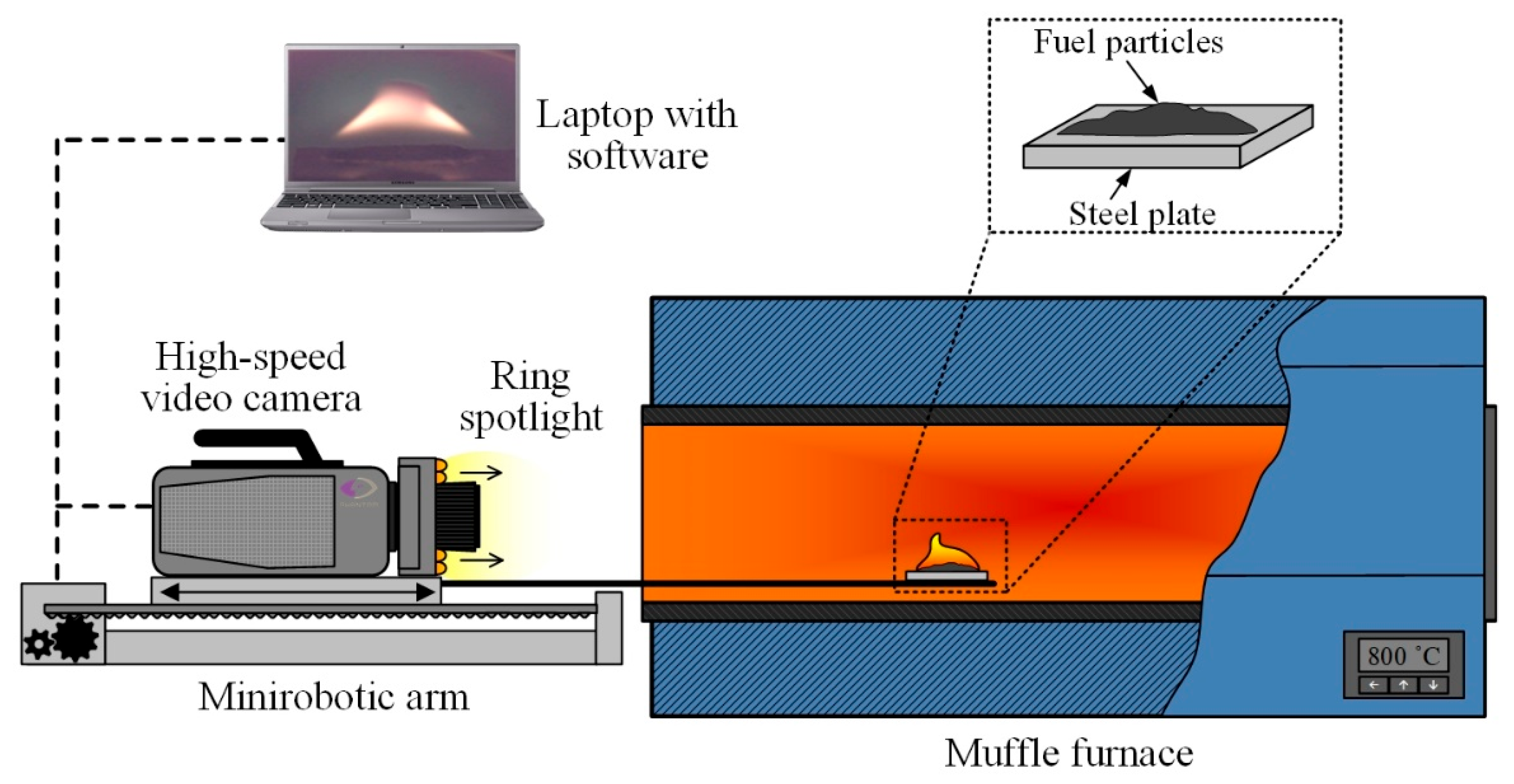

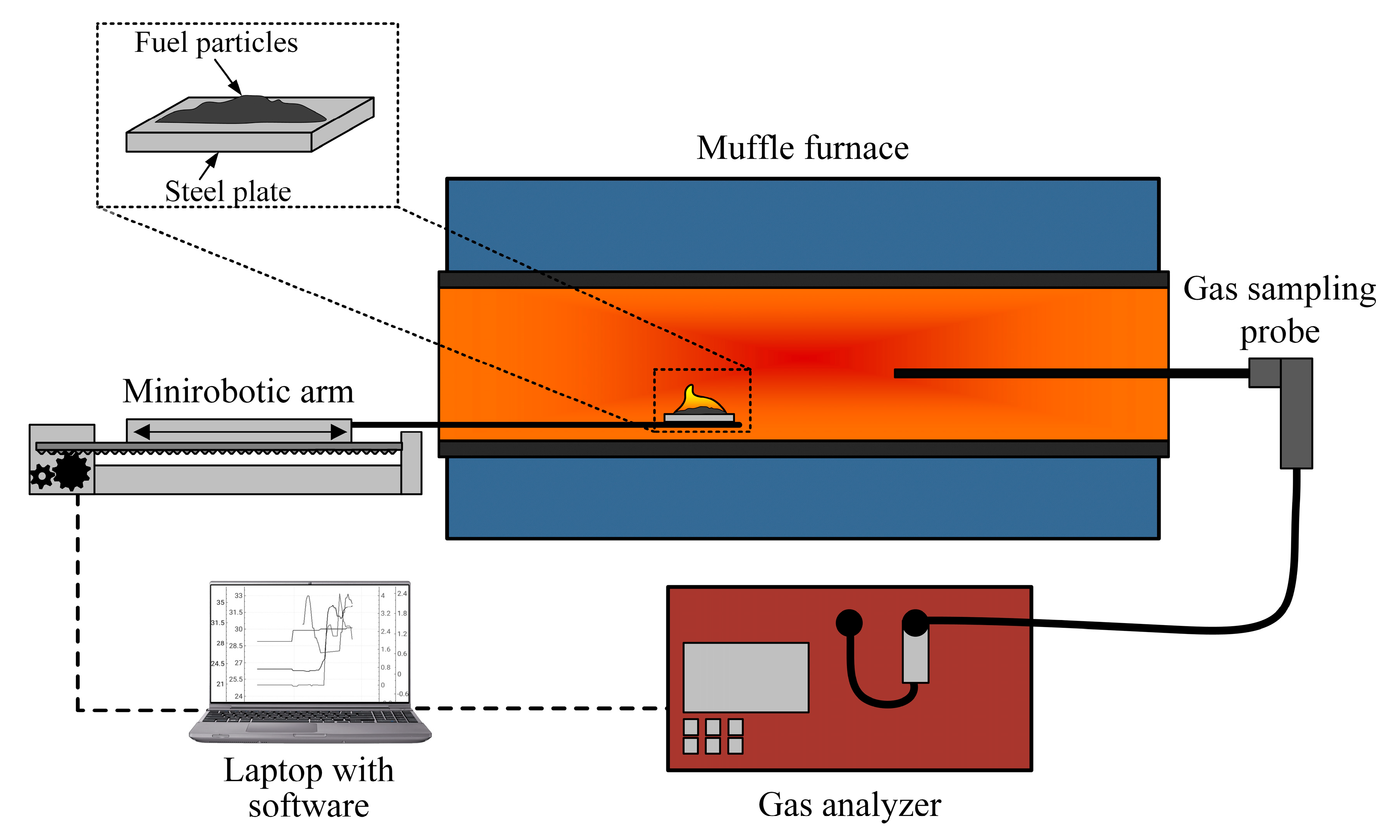
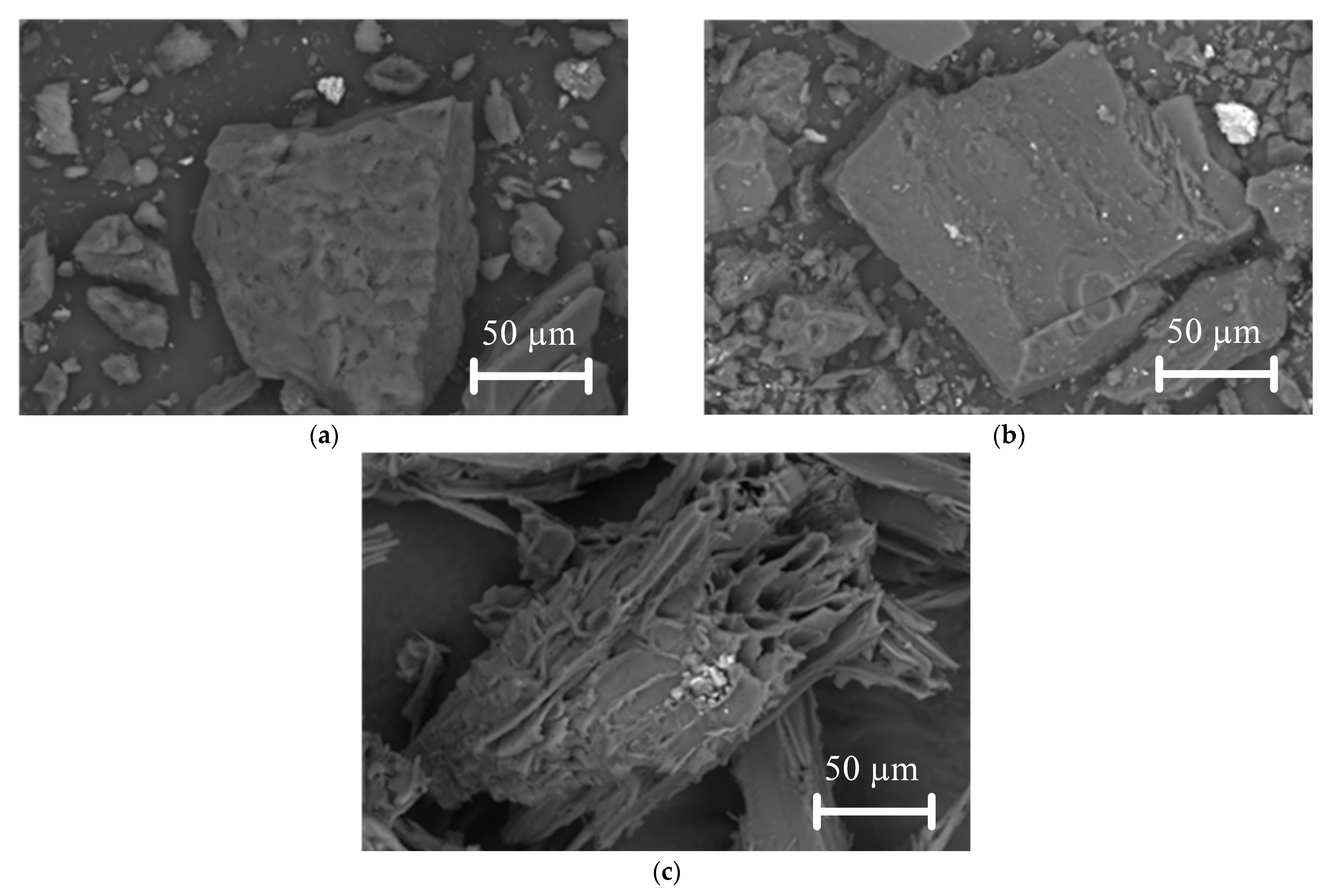








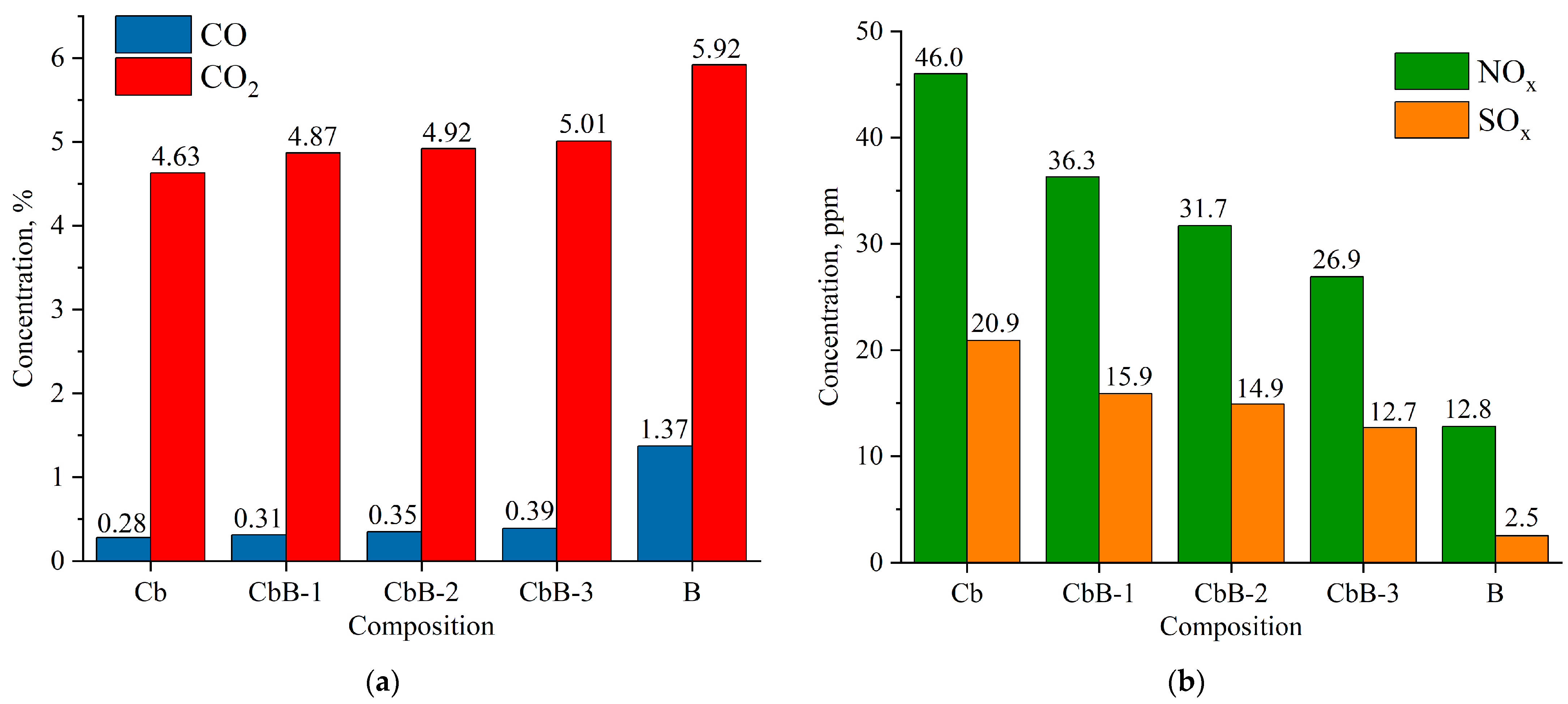

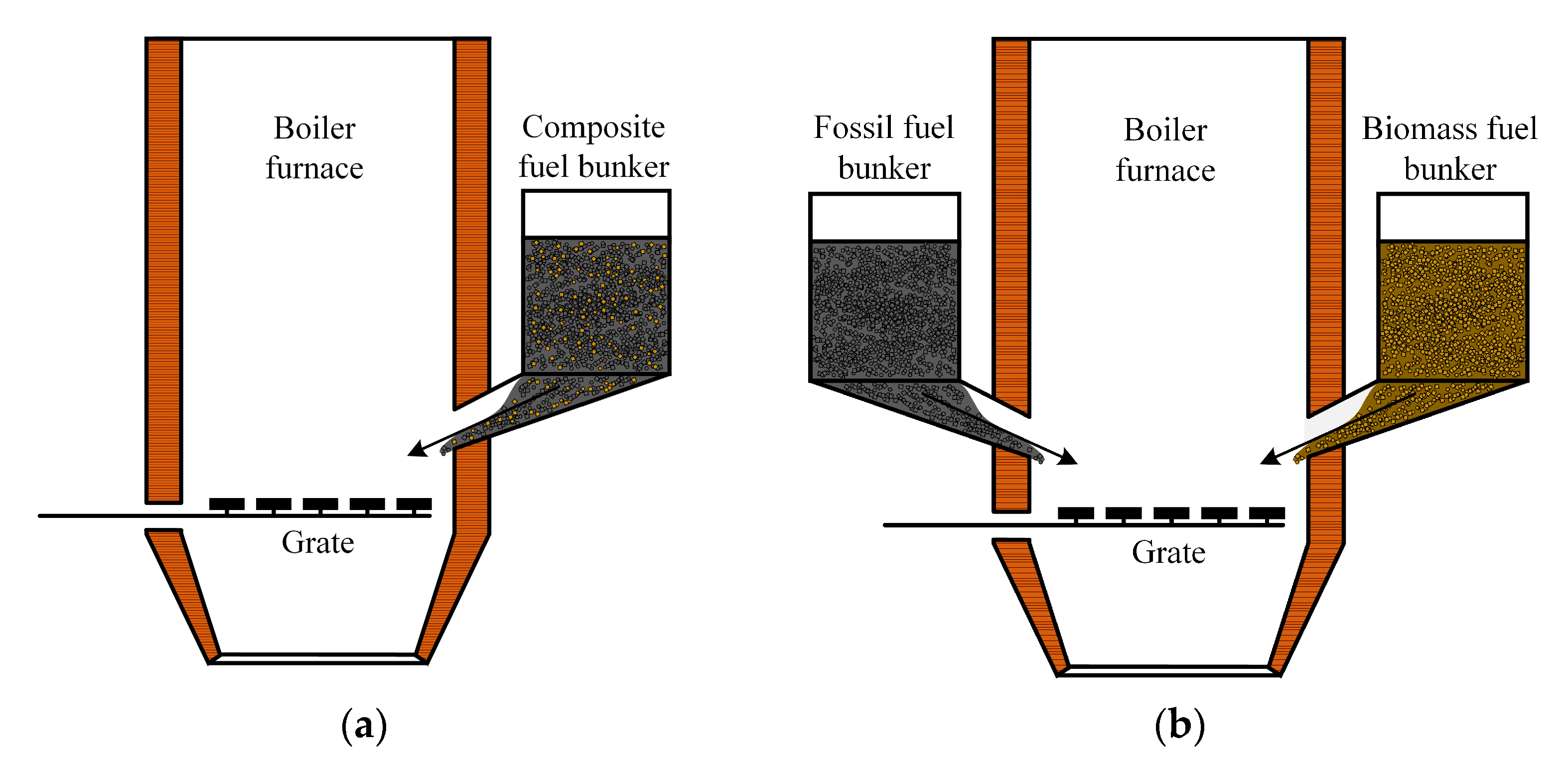
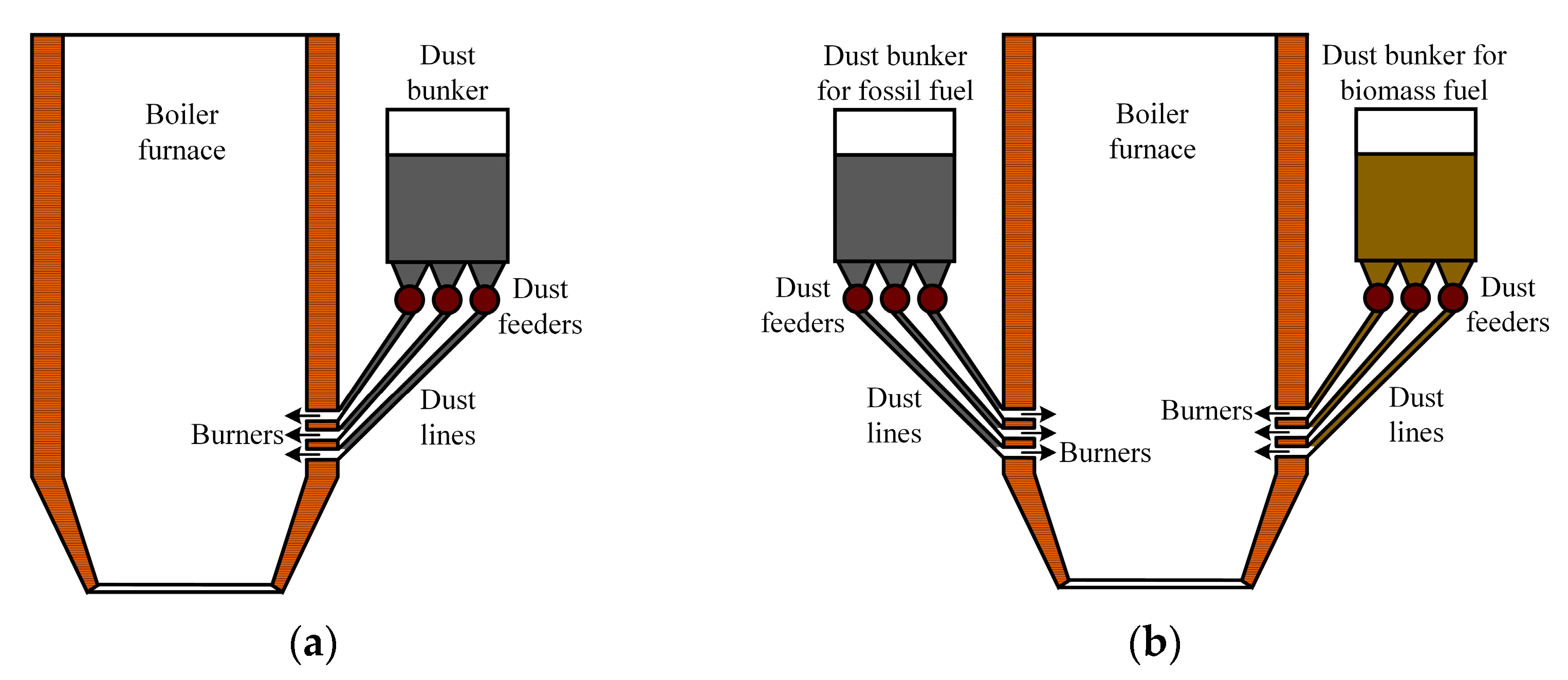

| Component Composition, wt.%. | Type Codes |
|---|---|
| Lignite 100% | Cb |
| Bituminous coal 100% | Ch |
| Biomass 100% | B |
| Lignite 90% + biomass 10% | CbB-1 |
| Lignite 80% + biomass 20% | CbB-2 |
| Lignite 70% + biomass 30% | CbB-3 |
| Bituminous coal 90% + biomass 10% | ChB-1 |
| Bituminous coal 80% + biomass 20% | ChB-2 |
| Bituminous coal 70% + biomass 30% | ChB-3 |
| Fuels | MC | Ad | VCdaf | HHV | Cdaf | Hdaf | Ndaf | Sdaf | Odaf |
|---|---|---|---|---|---|---|---|---|---|
| % | MJ/kg | % | |||||||
| Lignite | 32.6 | 9.2 | 47.3 | 24.19 | 73.5 | 5.1 | 1.0 | 0.3 | 20.1 |
| Bituminous coal | 13.0 | 17.8 | 44.0 | 31.00 | 77.5 | 5.2 | 2.1 | 0.6 | 14.6 |
| Biomass | 9.0 | 0.3 | 81.1 | 19.65 | 51.2 | 5.78 | - | - | 43.0 |
| No. | Ash | SiO2 | Al2O3 | Fe2O3 | CaO | MgO | TiO2 | Na2O | K2O |
|---|---|---|---|---|---|---|---|---|---|
| 1 | Lignite | 46.1 | 15.1 | 9.1 | 24.1 | 3.1 | 1.0 | 0.6 | 0.9 |
| 2 | Bituminous coal | 38.1 | 30.7 | 9.7 | 5.4 | 3.3 | 0.9 | 0.6 | 0.3 |
| 3 | Biomass | 1.69 | 0.83 | 1.26 | 62.4 | 11.3 | 0.42 | 0.97 | 12.4 |
| Fuel | B/A | BAI | Sr |
|---|---|---|---|
| Individual fuels | |||
| Cb | very high | low | high |
| Ch | very high | low | medium |
| B | high | high | high |
| Fuel mixtures | |||
| CbB-1 | very high | low | high |
| CbB-2 | very high | low | high |
| CbB-3 | very high | low | high |
| ChB-1 | very high | low | high |
| ChB-2 | very high | low | high |
| ChB-3 | very high | low | high |
Disclaimer/Publisher’s Note: The statements, opinions and data contained in all publications are solely those of the individual author(s) and contributor(s) and not of MDPI and/or the editor(s). MDPI and/or the editor(s) disclaim responsibility for any injury to people or property resulting from any ideas, methods, instructions or products referred to in the content. |
© 2025 by the authors. Licensee MDPI, Basel, Switzerland. This article is an open access article distributed under the terms and conditions of the Creative Commons Attribution (CC BY) license (https://creativecommons.org/licenses/by/4.0/).
Share and Cite
Zhuikov, A.; Glushkov, D.; Pleshko, A.; Grishina, I.; Chicherin, S. Co-Combustion of Coal and Biomass: Heating Surface Slagging and Flue Gases. Fire 2025, 8, 106. https://doi.org/10.3390/fire8030106
Zhuikov A, Glushkov D, Pleshko A, Grishina I, Chicherin S. Co-Combustion of Coal and Biomass: Heating Surface Slagging and Flue Gases. Fire. 2025; 8(3):106. https://doi.org/10.3390/fire8030106
Chicago/Turabian StyleZhuikov, Andrey, Dmitrii Glushkov, Andrey Pleshko, Irina Grishina, and Stanislav Chicherin. 2025. "Co-Combustion of Coal and Biomass: Heating Surface Slagging and Flue Gases" Fire 8, no. 3: 106. https://doi.org/10.3390/fire8030106
APA StyleZhuikov, A., Glushkov, D., Pleshko, A., Grishina, I., & Chicherin, S. (2025). Co-Combustion of Coal and Biomass: Heating Surface Slagging and Flue Gases. Fire, 8(3), 106. https://doi.org/10.3390/fire8030106







